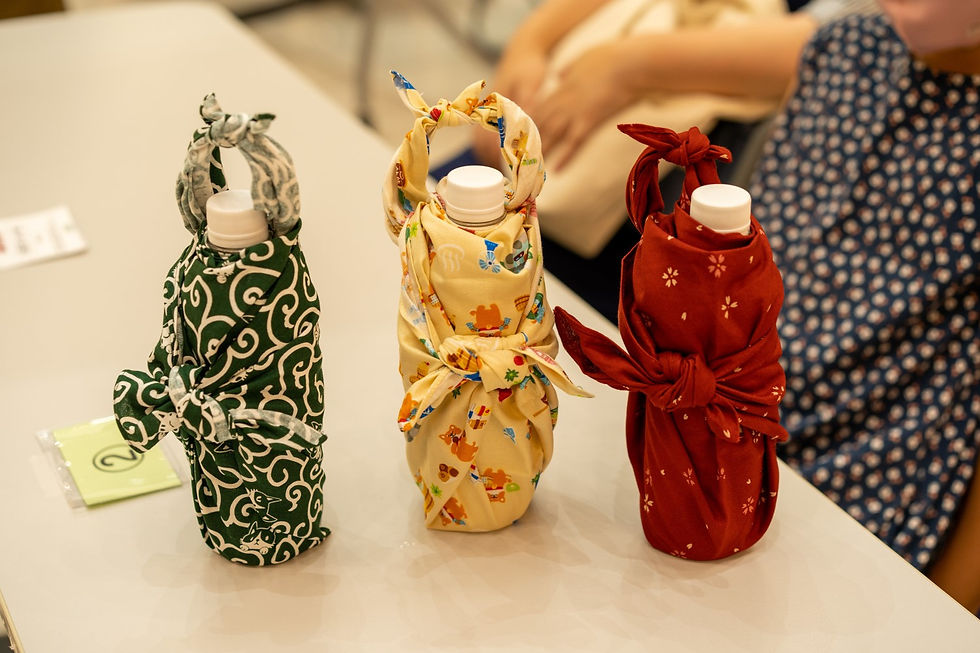May 2024
Cultural Article

Furoshiki
by Suzannah Nevas
This month was my husband’s birthday, and as I was scrounging in my closet for something with which to wrap his present, I found an old furoshiki I had brought back with me from Japan many years ago. As I googled proper folding techniques for the traditional Japanese wrapping cloth, I rediscovered my love and admiration for this beautiful (and practical!) part of Japanese culture.
“Furoshiki” comes from the words “furo”, bath, and “shiki” which can mean a mat to spread out or cover. In the 1300s, people visiting bath houses would wrap their belongings in a unique cloth called furoshiki. But the history goes back even further; the furoshiki’s predecessor, the tsutsumi, shows use dating back to the Nara period in the 8th century!
Over time, the furoshiki grew in popularity as well as application of use. In the modern era, furoshiki are used to wrap and carry things in addition to clothes, such as lunch boxes and presents.
These items can come in many shapes and sizes, and yet there is almost a one-size fits all approach when it comes to furoshiki. The Japanese Ministry of the Environment published a PDF diagram of “How to Use ‘Furoshiki’”, showing how the same cloth can be folded differently in order to wrap many differently shaped objects- including a watermelon, or two glass bottles!
The cloths themselves are almost but not quite square-shaped, usually coming in 45-50cm, 70cm, and 100cm. While they were traditionally made of silk, today you can also find them made from cotton, rayon or polyester. Furoshiki originally displayed family crests (demarcating the ownership of one’s things at the bathhouse), but now it is common to see them decorated with traditional or auspicious imagery from nature, and modern textile artists sometimes add a playfulness to their furoshiki designs.
(Image Sources (left to right): 2023-02-12 16.44.57 by albyantoniazzi, Panda Snowman furoshiki from Seria by Marceline Smith, Bear Furoshiki by Ted Laderas; each of these images are licensed under CC BY-NC 2.0 DEED)
The popularity of furoshiki took a dive when post-war consumerism spread across the world and plastic bags started popping up everywhere. However, in recent years, Furoshiki have made a cultural comeback as they dovetail nicely with the sustainability/eco-friendly trends we see today. Because the cloth isn’t pierced or damaged in the wrapping process, it can be re-used over and over again, proving to be much less wasteful than the disposable wrapping paper and curling plastic ribbon most often used in the West.
And don’t let cost deter you from switching over to the aesthetically elevated and sustainable art of Japanese wrapping cloth! While a very fancy furoshiki could sell for several hundred dollars, they can also be purchased in the $5-$10 range–not that differently priced from a roll of nice wrapping paper in the U.S.!
A few quick cultural disclaimers:
Be warned that furoshiki are not appropriate for very formal or ceremonial occasions-those call for the more formal, fukusa, textiles instead.
Also, when you do bring a gift wrapped in a furoshiki, the recipient will unfold it to reveal the gift inside, and it is understood that the furoshiki still belongs to the gift-bearer (though honestly, the furoshiki itself would make a splendid gift!).
I hope this has sparked your interest and I encourage you to peruse the internet as there are many online resources for purchasing furoshiki and learning different ways to fold and tie them.

Furoshiki cloth folded to carry bottled drinks
Sources:
https://en.wikipedia.org/wiki/Furoshiki
https://www.env.go.jp/en/focus/attach/060403-5.html
.png)





